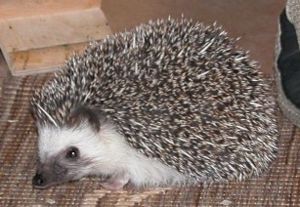White-bellied hedgehog
| White-bellied hedgehog | ||||||||||||
|---|---|---|---|---|---|---|---|---|---|---|---|---|

White-bellied hedgehog ( Atelerix albiventris ) |
||||||||||||
| Systematics | ||||||||||||
|
||||||||||||
| Scientific name | ||||||||||||
| Atelerix albiventris | ||||||||||||
| ( Wagner , 1841) |
The white-bellied hedgehog ( Atelerix albiventris ) is the most common species of the African hedgehog .
features
The white-bellied hedgehog is a small hedgehog, it reaches a head-torso length of 14 to 25 cm and has a short, 1 to 1.6 cm long tail. The rear foot length is between 2.6 and 2.9 cm. The spines are 5 to 10 mm long, the longest spines on the back measure 15 mm, on the head up to 17 mm. Its basal half is white, the upper half dark brown or blackish brown, often with a black tip, so that the spiked dress appears dark overall. The peritoneum is whitish or cream-colored. The legs are short and whitish. The hind foot has four toes. With a length of 7% of the head-trunk length, the tail is very short. The head is light, the region between the eyes and nose is black. The ears are small, round, and shorter than the spines surrounding them. Their length is around 73% of the length of the hind foot.
The white-bellied hedgehog can be easily distinguished from the Ethiopian hedgehog ( Paraechinus aethiopicus ), with which the white-bellied hedgehog occurs in central Sudan and southwestern Eritrea, by its much shorter ears (4–4.5 cm in P. aethiopicus ). The Somali hedgehog ( Atelerix sclateri ) is larger and has five toes on the hind foot.
distribution
The species occurs in the western Sudanese savannah located south of the Sahel region from Senegal to southern Sudan and South Sudan , as well as in western Somalia , Ogaden , Kenya , Tanzania , Uganda and Malawi . It is absent in the Ethiopian highlands and in the rainforest zone south of the Sudanese savanna region . There is an isolated occurrence in Zambia on the north bank of the Zambezi .
Habitat and way of life
The white-bellied hedgehog occurs in savannas, semi-arid and rocky areas; he avoids damp areas. It is common in gardens and agricultural areas. The animals are nocturnal and spend the day hidden under stones, tree trunks, in crevices or in a termite mound. White-bellied hedgehogs that were held in captivity were mostly active from 9:00 p.m. to 12:00 p.m. and around 3:00 a.m. The diet of the white-bellied hedgehog has so far been little studied. In East Africa they eat u. a. of worms, snails, freshwater crabs, insects as well as fruits, mushrooms and roots. Due to the large distribution area, the breeding season differs depending on the region, but is generally in the drier and cooler season.
The white-bellied hedgehog's predators include the milk cow ( Bubo lacteus ). Among the known ectoparasites include fleas cat flea ( Ctenocephalides felis ), Ctenocephalides crataepus , Echidnophaga gallinacea and the rat flea ( Xenopsylla cheopis ), moreover, the ticks Haemaphysalis leachi , Haemaphysalis spinulosa , brown dog tick ( Rhipicephalus sanguineus ) and Rhipicephalus simus . Other ectoparasites are mites such as Caparinia erinacei , Caparinia tripilis , Myocoptes musculinus , Notoedres oudemansi , Rodentopus sciuri and Sarcoptes scabiei .
White-bellied hedgehogs have a life expectancy of up to 10 years in captivity, but in the wild they rarely get older than 3 years.
Danger
The IUCN lists the white-bellied hedgehog as Least Concern.
literature
- DCD Happold: Atelerix albiventris White-bellied Hedgehog, pp. 31-33 in Meredith Happold and David Happold (eds.): Mammals of Africa Volume IV. Hedgehogs, Shrews and Bats. Bloomsbury, London 2013, ISBN 978-1-4081-2254-9
- Erica M. Santana, Holly E. Jantz, and Troy L. Best: Atelerix albiventris (Erinaceomorpha: Erinaceidae). Mammalian Species 42 (857), 2010, pp. 99-110
Web links
- Atelerix albiventris in the endangered Red List species the IUCN 2008. Posted by: Hutterer, R., 2008. Accessed November 10, 2015.
Individual evidence
- ↑ JT Raymond and MM Garner: Spontaneous tumors in captive - African hedgehogs (Atelerix albiventris): a retrospective study . In: Journal of Comparative Pathology . Volume 124, 2001, Issue 2-3, pp. 128-133. doi : 10.1053 / jcpa.2000.0441
